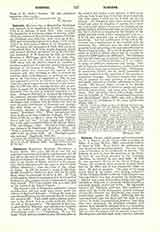

Schenute, (SCHENUDI, SCHNUDI, SINUTHIUS), a Coptic abbot. The years 332-33-34 and 350 are mentioned as the date of his birth, and the years 451-52 and 466 as the date of his death, all authors agreeing that he lived about 118 years. He was born at Schenalolet in the district of Akhim, and died in his monastery, which still exists under the name of Deir-el-Abiad (White Monastery), near the ruins of the village of Atripe. In 371, he became a monk at this large double monastery, which was then ruled by his uncle Bgol, whom he succeeded as abbot in 388. St. Cyril of Alexandria, whom he accompanied to the Council of Ephesus in 431, appointed him archimandrite during that council. The Copts honor him as a saint and as the Father of the Coptic Church.
The monastic rule of Pachomius underwent various modifications and was made more severe under the abbacy of Bgol and Schenute. Perhaps the most important modification was the introduction of vows into the monastic life. Each monk made a solemn profession in the church, that he would faithfully observe the rule of the monastery. The formula of this vow, as prescribed by Schenute, was published by Leipoldt (loc. cit. below, p. 107), and by Leclercq in “Dict. d’Archeologie chret.” s.v. Cenobitisme. It is as follows: “I vow [Greek: omologein] before God in His holy place as the word of my tongue is my witness: I shall never sully my body in any way; I shall not steal; I shall not take false oaths; I shall not lie; I shall not do evil secretly. If I transgress what I have sworn [omologein] I shall not enter the kingdom of heaven, for I know that God before whom I pronounce the formula of this pledge [diatheke] will thrust me body and soul into hell-fire, for I shall have trangressed the formula of the pledge [diatheke] which I have pronounced” (op. cit.). It is the first monastic vow of which we have any knowledge. Another modification of the rule of Pachomius was a combination of the cenobitic with the anchoretic life. Schenute was the most influential monastic head and perhaps the most powerful man in Egypt during his time. Besa, his biographer and successor as Abbot of Atripe, states that at one time he ruled over 2200 monks and 1800 nuns. But Schenute was too self-conscious, passionate, and tyrannical, his rule too severe, and his enforcement of it too violent, to make his influence wholesome and lasting. Outside of Egypt he remained unknown; neither Latin nor Greek writers make any mention of him. Philosophy he considered useless, and his whole knowledge of theology consisted in the repetition of the current ecclesiastical formulas. Extremely austere with himself, he required the same austerity of his disciples, and rigidly enforced an absolute submission to his authority. His literary works, written in the Sahidic language, consist chiefly of letters to monks and nuns, spiritual exhortations, and some very forcible sermons. They are being edited with a Latin translation by Leipoldt, in “Corpus Scriptorum Christianorum Orientalium” (Paris, 1906) and, with a French translation, by Amelineau in the same publication (Paris, 1907-.)
MICHAEL OTT

